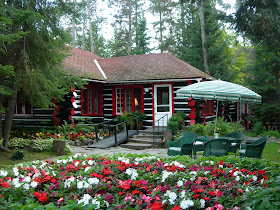Southern Quebec is blessed with more historic gardens than anywhere else in Canada. The ornamental gardening tradition in the province can be traced back to the beginning of colonization. After French explorer Samuel de Champlain established a settlement at Québec in 1608, the inhabitants planted a rose garden even as they struggled to stay alive in the sometimes-hostile environment of New France.
.
During the ensuing years of the French Regime, numerous gardens appeared in the city of Montréal and Québec. Period maps and other documents indicate that religious orders frequently developed extensive plots. The Ursulines, for instance, planted a flower garden in Québec City in 1642, while the Sulpicians constructed a walled garden at their seminary in Montréal around 1650. High-ranking officials, such as the governor and the intendant of Quebec, also supervised the creation of impressive gardens.
.
Plants and botanical information were exchanged regularly between Quebec and France. Indeed, a royal ordinance of 1726 obliged the captains of ships traveling to the colonies to bring back seeds and plants for the royal garden that had been inaugurated in Paris a century before.
.
After the British conquest in 1760, decorative gardening continued to flourish in Quebec, reaching unparalleled popularity in the second half of the nineteenth century. Some garden owners called on the services of landscape architects or designers; most did the planning themselves. In Montréal, Sherbrooke, the Eastern Townships, and Québec City, leading citizens kept plants indoors as well as outdoors. Fascinated by horticulture, Montreal’s industrial barons founded the Montreal Horticultural Society.
In 1937 landscape architect Louis Perron laid out the stunning Joan of Arc Garden in Quebec City, which surrounds a statue of the French heroine and harmonizes French and English garden styles. Visitors have an opportunity to admire over 150 species of bulbs, annuals, bulbs and especially, perennials. During summertime, hundreds of varieties ornate the flowerbeds, beneath the branches of the majestic elms. During Fall season, visitors can appreciate the warm colors of seasonal perennials and annuals. All October-long, Halloween decors await visitors, in the daytime or in the evening.
.
Reford Gardens is the Most Famous in the “Belle Province”
Ten-thousands of visitors will stroll through the enchanting 17-hectare grounds in Grand-Métis on the south shore of the St. Lawrence River. It was in the summer of 1926 that Mrs. Reford took up gardening at the age of 54. A wealthy Montrealer, she was convalescing after surgery at “Estevan,” a fishing lodge on a peninsula at the confluence of the Métis and St. Lawrence Rivers that she had inherited from an uncle and adopted as a country home.
As a pastime, she decided to create a garden alongside the lodge. She ordered a plot to be cleared, soil to be produced from peat, sand, and gravel from nearby farms and beaches, and compost to be rendered from the leaves of local deciduous trees.
.
Self-Taught Horticulturalist
Mrs. Reford had no formal education in horticulture. She could have afforded to hire a landscape architect, but she simply preferred to lay out the garden on her own. Over the next 30 years, she became more and more passionate about gardening. She continued to experiment and learn from her mistakes. She read voraciously, toured gardens in England, and exchanged tips with more experienced gardeners. She kept a detailed written record of her garden’s evolution, while her husband, Robert Wilson Reford, kept a comprehensive photographic record. Mrs. Reford’s original garden gradually expanded into six garden areas interspersed with sheltering woodlands.
Assisted by local employees, she built steps and terraces with stones from neighboring fields. She planted a dazzling diversity of indigenous and exotic plants, including gentians, lilies, meconopsis, peonies, primula, and roses. She designed a formal herbaceous border along the sides of a flagstone pathway known as the “Long Walk.” Otherwise, she incorporated wild-looking plantings, many of them on the banks of a stream meandering through the property.
In 1954 Mrs. Reford gave the estate to her son, Bruce. Seven years later, unable to meet the rising costs of upkeep, he sold it to the Quebec government. The province opened the gardens to the public but eventually put the site up for sale. Since 1995 it has been owned and run by Les Amis des Jardins de Métis, a non-profit corporation, and managed — with remarkable success — by Alexander Reford, Elsie Reford’s great-grandson.
.
Les Quatre Vents
During the 1930s, an American family by the name of Cabot took up gardening in Cap à l’Aigle, on the north shore of the St. Lawrence River. Their gardens, “Les Quatre Vents,” ultimately covered more than eight hectares. On occasion, owners themselves have ensured the conservation of their gardens. Prime Minister Mackenzie King bequeathed his Gatineau estate, which features picturesque gardens and reconstructed ruins, to the government of Canada. The park is named Kingsmere.
.
Recognizing Heritage Gardens
The federal Department of Canadian Heritage and the provincial Ministère de la culture now consider historic gardens eligible for funding. Parks Canada has plans to restore the gardens at the Manoir Papineau National Historic Site in Montebello.
“For centuries,” Alexander Reford concludes “gardens constituted a vital element of Quebec’s heritage. They deserve to remain that way.”
.
Read more:
https://www.theglobeandmail.com/news/national/his-quebec-garden-called-canadas-best-kept-secret/article4179930/
https://www.gardenvisit.com/gardens/in/canada/quebec
https://www.gardenvisit.com/gardens/montreal_botanic_garden
https://www.refordgardens.com/
https://garden.org/learn/articles/view/1124/
https://www.thecanadianencyclopedia.ca/en/article/historic-gardens
https://hudson.quebec/en/location/the-history-garden/
.
<><><><><>
.












